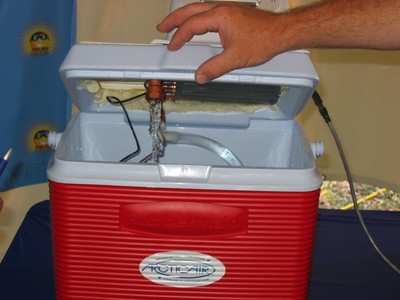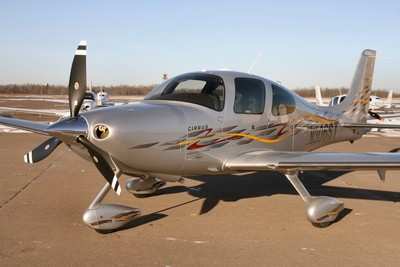ANN's Top 10 (OK, 12) Products/Programs Of 2006
When it comes to the people, planes and products of the aviation
business, ANN firmly believes there is no such thing as an
embarrassment of riches. 2006 saw a spate of new programs and
'gadgets' designed to separate a pilot from his flying dollar...
fortunately, the vast majority of them are quite worthy of
foregoing the occasional $200 hamburger or two.

In fact, for 2006 we've had to increase the size of our annual
'Best Of' list to an even dozen to accomodate them all.
From established products that continue to impress, to new and
exciting developments across the range of general aviation... here,
to our eyes, are the first three out of our list of the 12 most
worthy 'gadgets' and programs of 2006.
Arctic Air
The timing couldn't have been any better. Early on a hot and
humid April morning at Lakeland 2006, Cirrus announced their new,
optional air conditioning system for the SR22. Advanced, fully
automatic, set-and-forget... and $19,900 installed.

Given the heat and humidity on that sweltering central Florida
day, that seemed entirely reasonable to me. But then another ANN
Staffer and I attended a press conference held by Greg Turton,
inventor of a contraption called Arctic Air -- an albeit
cruder system than Cirrus', though just a little
cheaper... to the tune of around $600 for a top-of-line model.
Turton's innovation consists of a Rubbermaid cooler, modified
with a two-speed brushless fan (so as not to interfere with the
aircraft's electronics), pump, condenser coil, and power cord
mounted to the cooler's lid. Tubing leads from that assembly, down
into the cooler tub. To use the system, fill up the cooler with ice
and just a little water, replace the lid, plug the unit into the
aircraft's 12-volt power supply (or a battery pack) and turn the
two-speed fan to the higher of two settings.

The fan draws the heated outside air into the cooler, which
melts the ice. That cool water is then pumped through the condenser
coil, and the cooled air -- 190 cubic feet per minute -- is blown
out by the fan.
And voila, air conditioning -- with no STC required. The system
only draws approximately 4.5 amps from the aircraft's power supply,
with no engine power penalty. The cooling power is limited only by
the amount of ice in the cooler -- with the smallest 24-quart
system offering about an hour of cooling on the higher fan setting,
or up to four hours on low cool.

Furthermore, the system is fully portable, and can be used in
all phases of flight, on practically any aircraft (incidentally,
Turton flies a Cirrus.) You can also take it with you to go
camping, and there was talk at Lakeland of offering systems to aid
people recovering from natural disasters in hot climates.
In an age of increasingly complex aircraft systems... the ANN
staff was taken with the sheer ingenuity and simplicity of Arctic
Air. It's our "Better Mousetrap" winner of the year.
Cirrus Access
Buy a plane... get a pilot. That's the concept behind Cirrus Access, a program well
worth its rather significant pricetag.

For the sum of around $85,000 -- on top of the $500,000 sticker
for a new SR22 -- Cirrus will provide a new owner with an on-call
pilot for the first year of Cirrus ownership. But you don't just
get a pilot... you also get your own CFI, who will train you to
operate your new Cirrus aircraft on your terms, and on your own
timeframe.
Talk about the ultimate training program -- imagine being flown
to a business meeting, in your plane, with an experienced flight
instructor along for the ride to instruct you in the operation of
your plane... or, to fly you to your destination as you sit back
and get some business done.
Access is the first step in what has evolved into what Cirrus
terms a Culture of Safety -- a concerted effort by the company to
make sure new Cirrus pilots know their plane's capabilities, and
how to safely explore those capabilities.

In fact, Cirrus Access pilots aren't allowed to solo their
planes for the first 50 hours... better to ensure the pilot is
fully prepared to safely operate their aircraft.
Yes, it's expensive... but it's also the most thorough new
ownership program available to GA pilots today, by a substantial
margin -- possibly qualifying the program, also, as a legitimate
'bargain.' Well done, guys.
Columbia E-Vade
No moving parts... no messy deicing fluid. Columbia Aircraft
continued to impress in 2006 with its all-electronic E-Vade icing
protection system, available on the Columbia 400.

E-Vade is a carryover
technology, from the days when Columbia was known as the certified
branch of The Lancair Company. Developed by Northcoast Technologies
-- which was subsequently bought out by Kelly Aerospace Thermal
Systems in 2005 -- ThermaWing employs a laminate tape of flexible,
expanded graphite between an outer, heat conducting, layer and an
electrically insulating inner layer.
The tape is heated by electricity generated by an increased
capacity alternator specified for the installation. Deice and
anti-ice functions are performed by a patented system that cycles
and rapidly transfers power to multiple sections of the tape. This
tape is bonded to the leading edge surface of the Columbia's wings
and horizontal stabilizer. A heated prop and optional icing window
completes the package.
 Our enthusiasm for E-Vade is
tempered slightly by reports that surfaced this year of problems
with the installation. On some planes, a short circuit condition at
the deice heater connector to the copper mesh material imbedded in
the composite aeroplane structure (for lightning protection) caused
burning of the wings and horizontal stabilizer, which created holes
in the structure.
Our enthusiasm for E-Vade is
tempered slightly by reports that surfaced this year of problems
with the installation. On some planes, a short circuit condition at
the deice heater connector to the copper mesh material imbedded in
the composite aeroplane structure (for lightning protection) caused
burning of the wings and horizontal stabilizer, which created holes
in the structure.
The FAA and Australia's CASA issued Airworthiness Directives to
address the problem, where a short circuit is caused by
insufficient removal of copper mesh when the deice heater
connectors are installed.
Fortunately, a fix is in the works... and this technology is
simply too promising to be overshadowed by what appears to be a
temporary, developmental, glitch.
Coming Tuesday... The Next Three Selections For
ANN's Best Programs And Gadgets Of 2006
 ANN's Daily Aero-Linx (04.13.24)
ANN's Daily Aero-Linx (04.13.24) ANN's Daily Aero-Term (04.13.24): Beyond Visual Line Of Sight (BVLOS)
ANN's Daily Aero-Term (04.13.24): Beyond Visual Line Of Sight (BVLOS) Airborne 04.09.24: SnF24!, Piper-DeltaHawk!, Fisher Update, Junkers
Airborne 04.09.24: SnF24!, Piper-DeltaHawk!, Fisher Update, Junkers Aero-News: Quote of the Day (04.14.24)
Aero-News: Quote of the Day (04.14.24) ANN's Daily Aero-Term (04.14.24): Maximum Authorized Altitude
ANN's Daily Aero-Term (04.14.24): Maximum Authorized Altitude










